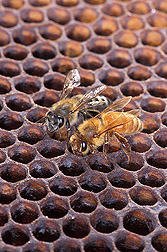The map only highlights area where DNA tests have been performed on bees. Other areas may have had DNA tests done but those didn't show up with AHB DNA. It doesn't mean they aren't there. It just means they haven't established themselves.

The bee on the left is suppose to represent the appreance of the Apis mellifera scutellata (Africanized Bee) What is realy funny is all my bees look like that one.
edited to add:
Okay my brain is going now. The european honeybee is suppose to be slightly larger than the AHB. Do they mean european bees raised in standard hives with larger cell foundation ? One of the things I have noticed doing cutouts is how much smaller the bees are. Feral bees do not always mean Africanized bees. However it means bees without chemicals and those that have had time to regress to a natural cell size.
Also the picture really bugs me because the only bee I have seen that resembles the european honeybee in the picture is the queen. The queen tends to have a abdomen that is much less striped than those of the worker bees. So maybe I am losing it or maybe I am raising AHB's and doing it right. Although I doubt that seriously.

The bees I removed from the compost bin.

Bees I have been raising for a year now. You may have to make the image large to see the detail.
I think I am frustrated because the image shows a dramatic difference in appearence, yet everything else I have read says the only way to tell is with a DNA test.
Sincerely,
Brendhan